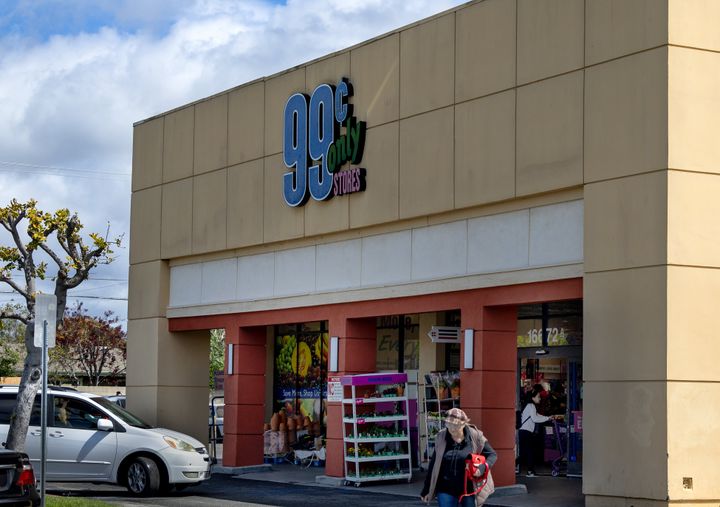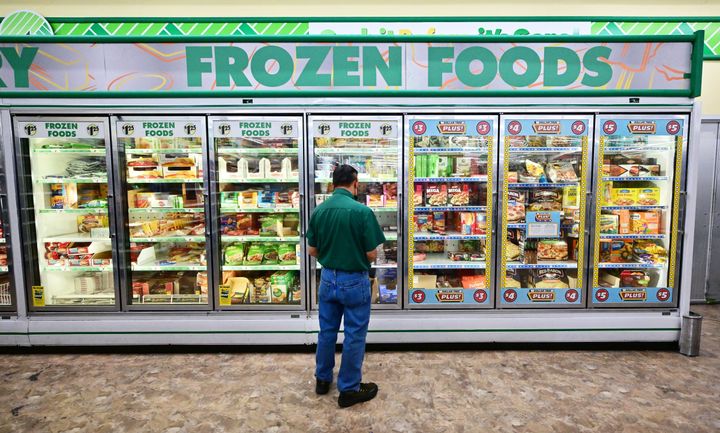
When Daniel Campos heard that the 99 Cents Only stores were shuttering all 371 locations late last week, a surprising wave of emotions hit him.
As the child of immigrants, Campos, a Los Angeles native, said the 99 Cents Store was “an institution” ― a place where you could get a dollar Hot Wheels toy or an ice cream bar while your parents stocked up on groceries, household cleaning items and chintzy decorations for family parties.
“For those of us that grew up in a low-income background, this place meant a lot to us,” Campos, the chief creative director at XXXDCD Clothing, told HuffPost. “As a kid, if your parents drove by it and stopped, you knew you were in for a treat.”
Because the inventory was always shifting in and out, there was a “treasure hunt” quality to visiting the store: One week you’d find off-brand Barbie dolls and Star Wars-branded “space punch,” the next, marked-down Halloween decorations and a hair cap with packaging that inexplicably featured Beyoncé. (Something tells us she didn’t license that one.)
Growing up, Campos usually beelined to the ice cream section before snatching up a bag of Hot Cheetos. As an adult, he valued the store for its healthier options: You could be dead broke but never feel like it because the 99 Cents Store kept you well fed with Yukon Gold potatoes, tortillas, milk, rice, fresh produce (grapes, avocados, lettuce and bell peppers) and canned ones, too.
As columnist Gustavo Arellano wrote in the Los Angeles Times on Tuesday, “Even though it was a multibillion-dollar company, 99 Cents Only operated under a premise straight from the Great Depression: a fair shake for everyone who entered.”
That’s what Campos loves ― or loved, as it were ― about the store, too.
“They have vegetables, eggs, milk and so many of the name brand products you’d find at a regular grocery store,” he said. “For me, it turned into a nostalgia of remembering where I would get snacks to, wow, this is where I can get essentials at a much lower price.”
The discount chain, which operates in California, Arizona, Nevada and Texas, made the closure announcement on Friday, citing COVID setbacks, inflation and product theft.
The stores, which first opened their doors in 1982, began liquidation sales on Friday. Social media, TikTok in particular, is full of videos of penny-pinchers scouring the aisles for one last haul.
The 99 Cents Store news comes on the heels of an announcement that nearly 600 Family Dollar locations are set to close this year, while 400 more stores under the Family Dollar and Dollar Tree banners are expected to close in the next few years as their leases expire.

Dollar stores like the 99 Cents Store are surprisingly polarizing.
According to a 2022 USDA economic research report, more than 1 in 10 households in the U.S. deal with food insecurity, meaning they can’t access the food that they need ― with inflation and the end of pandemic-era aid, those numbers only rose higher.
The presence of dollar stores in lower-income communities affected by food insecurity is a polarizing topic: As The New York Times reported last year, since 2019, at least 75 communities have voted down proposed dollar stores, while roughly 50 have enacted moratoriums or other broad limits on dollar store development. But why?
Critics say national discount chains like Dollar Tree undercut local grocers with their low prices and exacerbate “food deserts” ― communities where shoppers have little or no access to grocers offering healthier foods, but no shortage of liquor stores and snack-filled corner markets.
Sarah Portnoy, a professor of Latinx food studies at the University of Southern California and the creator of the “Abuelitas on the Borderlands” documentary series, thinks the 99 Cents Store was different.
“Dollar stores like the 99 Cents Store sell affordable produce, even organic produce at times, in areas where it can be challenging to get to a large chain supermarket,” she told HuffPost.
In big cities such as Los Angeles, low-income residents often live more than a mile from a grocery store and must rely on public transportation, Portnoy said. Well-stocked dollar stores are often a solid alternative to full-service grocery stores.
“The loss of dollar stores in underserved communities has repercussions that extend far beyond the financial ones to the health of the community,” Portnoy said, noting that in underserved communities, rates of diabetes and obesity are far higher than in more affluent communities, where the number of full-service grocery stores per capita is up to three times higher.
Susana Medina, a resident of Los Angeles, was raised by a single mom and remembers making weekly treks to the local 99 Cents Store, where her mom would stock up on fruits and vegetables.
“With three kids, money was tight so shopping at the 99 Cents Store was a must,” she told HuffPost. “It was basically the only option.”
Now a mom herself, Medina said she appreciates the store’s healthier items she can build meals around for her daughter.
“Whenever I’m looking for anything, I try looking for it at the 99 Cents Store first before shopping at another store,” she said. “I love their canned chunk light tuna in water and pre-cut cabbage that comes in the coleslaw bags. They also have the best saltine crackers that I haven’t found elsewhere yet.”
After hearing news of the closures, Medina spent back-to-back days at different locations, stocking up on hair dye, cutlery, kitty litter and tooth brushes, among other things. Like many, she shared her liquidation haul on TikTok.
Others have more complicated feelings: Writer An Uong said that growing up poor in Southern California’s San Fernando Valley, the 99 Cents Store was her family’s lifeline to affordable foods.
“We had canned tuna on rice, Vienna sausages on rice, sardines in tomato sauce on rice ― a lot of canned things on rice, basically,” said Uong, who now lives on the East coast.
“As much as it kept us well-fed, it also set my family up for a dependency upon foods that were cheap but not the best for our bodies,” she continued. “It’s a complicated relationship. Even so, the 99 Cents Store will always be a place of small joys.”
Due to inflation, prices at the store had gone up in recent years ― some customers were so incensed by price jumps in 2010, they sued ― but Medina thinks it remained a discount shopper’s dream, even up until the end.
“Plus, going to the store always reminds me of my mom, who passed away in 2020,” she said. “I know that if she was still alive, she would be heartbroken about this news, like so many of us bargain shoppers.”
Vandana Sheth, a registered dietitian nutritionist and diabetes care specialist, has seen firsthand how dollar stores provide access to nutrient-rich options for many families. She knows clients that sometimes have to choose between food and medications because of financial strain, but the 99 Cents Store provided a lifeline, offering affordable yet nutritious groceries that didn’t break the bank.
“I actually used to lead nutrition workshops for low-income families where I discussed how to shop smart at the 99 Cents Store,” she added. “We’d then cook meals using ingredients from there, proving that healthy eating is possible on a budget.”
!["[Dollar stores] are a main source of affordable food for many. How will people manage when a store like this closes?" said Kayla de la Haye, a research scientist and the director at the Institute for Food System Equity at the University of Southern California.](https://img.huffingtonpost.com/asset/6615b1632200005900fc6836.jpeg?ops=scalefit_720_noupscale)
Sheth said the local store near her office in Torrance, California, almost always had some variation of leafy greens, herbs, cauliflower, broccoli, zucchini, cucumber, tomatoes, potatoes, green beans, apples, mango, melons, avocado and berries.
The canned and frozen food aisles at dollar stores are underrated, too, said Krista Linares, a registered dietitian in Los Angeles.
“People forget that canned and frozen vegetables are more affordable and offer plenty of nutrition,” she said. “Canned vegetables are especially important because they’re shelf stable, in addition to being an affordable way to buy vegetables.”
Experts are looking for longer-term solutions to food insecurity.
Even for those outside of food deserts, grocery prices are rising due to inflation, and Linares considers the 99 Cents Store one of the last truly accessible healthy food purveyors.
So does Kayla de la Haye, a research scientist and the director at the Institute for Food System Equity at the University of Southern California.
“It’s not that dollar stores are the ideal food source ― they’re known to offer less nutritious food compared to grocery stores,” she told HuffPost. “But they are a main source of affordable food for many. How will people manage when a store like this closes?”
In LA, where most of the 99 Cents Stores are located, 1 in 4 (25%) residents live in a food desert that has poor access to a grocery store (vs. 17% nationally), and 30% are food insecure (vs. 12% nationally).
Almost always, “It’s residents who are low income, Latino and Black who face most of the burden of these food inequities,” de la Haye said.

There’s been one promising development since news of the closures broke: On Friday, Mark J. Miller, the CEO of Pic ‘N’ Save Bargains and former president of Big Lots, told Los Angeles Magazine that he hopes to put together a group of investors, including some former 99 Cents Store executives, to try and save some of the stores in Southern California.
“It’s a passion for me to try and do this deal because I think it’s such an iconic brand name and has such a great feel for Southern California,” Miller told the magazine.
But to really get at the root of the problem, de la Haye thinks solutions need to go deeper than that. As she noted, in the U.S., what we eat is the leading cause of illness and death, but there are ways to change that.
“This is really a time to take action, and use this as an opportunity to help communities who rely on dollar stores gain new options to access affordable, healthy and good quality food,” she said. “Because ultimately, we are fortunate to live in a wealthy country that has a food supply that could feed everyone; we even throw out about a third of this food!”
One idea that has taken off in LA is providing small grants to local markets so they can build up their capacity to sell healthy foods.
“We have a lot of work to do to make sure all people have not just food security, but also nutrition security, meaning they can access and afford healthy food,” de la Hay said. “If we can make it easier for all people to access healthy, affordable, good quality and tasty food, there would be so many benefits for our health and well-being.”